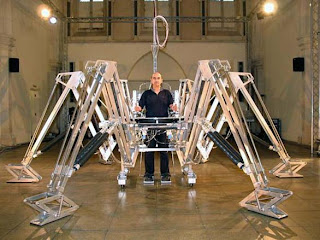
Stelarc (Stelios Arkadiou) is a Cypriot-Australian performance artist whose works focuses heavily on extending the capabilities of the human body. As such, most of his pieces are centred around his concept that the human body is obsolete. I don't know what to say about it. It is really really incredible. The robotic technology is developing more and more. Maybe robots will definitely be replace human's works. The Muscle Machine is a six-legged walking robot, five metres in diameter. It is a hybrid human-machine system, pneumatically powered using fluidic muscle actuators. The rubber muscles contract when inflated, and extend when exhausted. This results in a more flexible and compliant mechanism, using a more reliable and robust engineering design. The fluidic muscle actuators eliminate problems of friction and fatigue that were a problem in the previous mechanical system of the Hexapod prototype robot. The body stands on the ground within the chassis of the machine, which incorporates a lower body exoskeleton connecting it to the robot. Encoders at the hip joints provide the data that allow the human controller to move and direct the machine as well as vary the speed at which it will travel. The action of the human operator lifting a leg lifts the three alternate machine legs and swings them forward. By turning its torso, the body makes the machine walk in the direction it is facing. Thus the interface and interaction is more direct, allowing an intuitive human-machine choreography. The walking system, with attached accelerometer sensors provide the data that generates computer structured sounds augmenting the acoustical pneumatics and operation of the machine. The sounds register and amplify the movements and functions of the system. The operator composes the sounds by choreographing the movements of the machine. Once the machine is in motion, it is no longer applicable to ask whether the human or machine is in control as they become fully-integrated and move as one. The 6-legged robot both extends the body and transforms its bipedal gait into a 6-legged insect-like movement. The appearance and movement of the machine legs are both limb-like and wing-like motion.

No comments:
Post a Comment